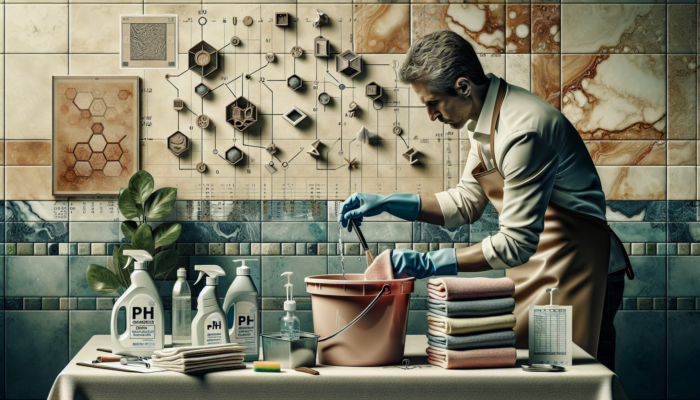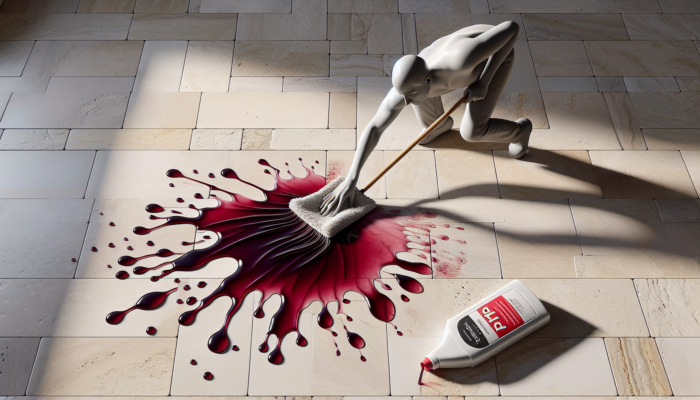Master the Art of Cleaning Travertine Tiles: Proven Strategies for Pristine Surfaces
Essential Supplies You Need for Immaculate Travertine Tile Care

To successfully clean your travertine tiles, you must take a meticulous approach that preserves both their inherent beauty and structural integrity. Start by gathering the essential cleaning supplies, ensuring each item is both gentle and effective for achieving optimal results. A high-quality pH-neutral cleaner is vital, as it will not etch or damage the tile surface, thus maintaining its natural elegance. Soft cloths, particularly <a href="https://fabritec.org/clean-travertine-tile-essential-tips-and-techniques/">microfiber towels</a>, are ideal for applying cleaning solutions and drying the tiles without the risk of scratches. Additionally, prepare a bucket filled with warm water to help dilute your cleaning solution and efficiently rinse the tiles. Remember, having the right tools is crucial for achieving a spotless finish on your travertine surfaces.
In addition to the primary cleaning agents, it is wise to have a soft-bristled brush or mop readily available. These tools will assist in gently working the cleaner into the tile’s surface, which facilitates the removal of dirt and grime while significantly reducing the risk of scratches. Moreover, a vacuum cleaner is beneficial for eliminating loose debris before beginning the cleaning process. Preventing the accumulation of dirt is essential for the long-term maintenance of your tiles, as it greatly reduces the need for more intensive cleaning methods in the future.
While preparing your supplies, do not underestimate the importance of your workspace. A well-organised and tidy area, where all your tools are easily accessible, will enable a more efficient cleaning process. This preparatory phase is critical for ensuring effective cleaning and allows you to work without interruptions. Consequently, this significantly reduces the risk of oversights that could potentially damage your cherished travertine tiles.
Safeguarding Adjacent Areas During Your Travertine Cleaning Process
Before you commence the cleaning process, it is imperative to protect surrounding areas to prevent any unintended damage. Safeguard furniture, baseboards, and nearby surfaces with plastic sheeting or old sheets. Secure these coverings with painter’s tape to ensure that no cleaning solution seeps through. This precaution is particularly important in homes where travertine tiles are located in high-traffic zones or near furnishings that could easily be splashed during the cleaning process.
Thoroughly shielding your workspace helps protect it from moisture and potential staining caused by cleaning residues. If your tiles are situated in a kitchen or dining area, exercise additional caution around appliances and cabinetry, as these surfaces can be particularly susceptible to cleaning residues and drips, which can lead to unsightly marks.
Additionally, if you have delicate items nearby, such as artwork or decorative pieces, consider temporarily relocating them to a safer location. This foresight will provide peace of mind as you focus on cleaning your travertine tiles, knowing that you have taken the necessary steps to safeguard your home’s aesthetics against any possible mishaps.
Eliminating Loose Debris Before Beginning Your Cleaning Routine
Before applying any cleaning solutions, it is crucial to clear away loose debris from the travertine surface. Start by sweeping or vacuuming the area to eliminate dust, dirt, and small particles that could potentially scratch the tile during cleaning. A soft broom is particularly effective for this task, as it efficiently collects debris without harming the travertine’s finish and texture.
If you opt for vacuuming, utilise a vacuum cleaner equipped with a soft brush attachment. This method ensures thorough cleaning of the tile without risking scratches on the surface. Pay special attention to the grout lines, as dirt and dust often accumulate in these crevices, leading to discolouration and a less appealing appearance over time.
After clearing away loose debris, carefully inspect the tiles for any visible stains or marks. Identifying these issues before cleaning allows you to tailor your cleaning strategy effectively. An informed approach not only enhances the appearance of your travertine but also prolongs its lifespan, ensuring your tiles maintain their stunning look for years to come.
Establishing a Sustainable Daily Maintenance Routine for Travertine Tiles

Integrating Regular Sweeping into Your Travertine Maintenance Strategy
Consistent sweeping is essential for maintaining the beauty and durability of your travertine tiles. A soft broom is the best tool for this task, effectively removing dust and dirt without scratching the surface. Regular sweeping also prevents the accumulation of debris, which can lead to scratches when walked on or when cleaning solutions are applied.
In high-traffic areas, such as hallways or living rooms, aim to sweep daily to keep the tiles in optimal condition. A less frequent sweeping schedule might suffice for less frequented spaces, but it remains vital to do so regularly to maintain the tiles in pristine shape. The combination of consistent sweeping and more thorough cleaning sessions will significantly contribute to the overall health and longevity of your travertine flooring.
A dust mop can also prove beneficial, particularly for accessing those hard-to-reach corners where a broom might struggle. The design of the dust mop allows you to effectively capture fine particles and dust, ensuring that your travertine remains clean and inviting. By integrating these daily maintenance habits into your routine, you will be rewarded with tiles that not only look fantastic but also withstand the test of time.
Mopping with Care to Safeguard Your Travertine Tiles
When mopping your travertine tiles, exercising caution is essential to avoid damaging the surface. A damp mop is your best option—never soak the mop in water, as excessive moisture can seep into the porous structure, potentially leading to lasting damage. Instead, utilise a mild, pH-neutral cleaner specifically formulated for stone surfaces. This ensures that your cleaning method is both effective and gentle, preserving the integrity of the tiles without compromising their appearance.
Be sure to work in sections, applying the cleaner and then mopping it up as you go. This technique prevents the solution from drying on the tile, which could result in streaks or residue that detract from the overall aesthetic. For optimal results, choose a soft microfiber mop head that won’t scratch the travertine’s surface. This thoughtful approach guarantees a thorough clean while safeguarding the natural beauty of your tiles.
Once you have mopped the entire area, it’s advisable to follow up with a clean, damp mop to eliminate any residual cleaning solution. Allowing the tiles to air dry is best, as this helps prevent water spots and streaks. Proper mopping not only enhances the shine of your travertine tiles but also significantly contributes to their longevity and overall appeal.
Taking Swift Action on Spills to Prevent Permanent Staining

Spills on travertine tiles must be addressed immediately to avert unsightly stains and maintain the natural beauty of your flooring. Prompt action is imperative, whether it’s a splash of red wine or a drop of cooking oil. Start by blotting the spill with a soft cloth or paper towel; avoid rubbing, as this can spread the liquid and exacerbate the issue, making it harder to clean.
Once the surface has been blotted, rinse the area with warm water and a pH-neutral cleaner to eliminate any lingering residue. This thorough approach ensures that no substances remain that could lead to discolouration or staining over time, safeguarding the integrity of your travertine tiles.
Educating those who frequent the area—especially children and pets—about the importance of spill management is vital. Consider placing mats in high-risk areas, such as kitchens or dining rooms, to catch any potential spills before they affect the travertine. By fostering a habit of immediate cleanup and preventive measures, you can maintain the pristine condition of your travertine tiles for years to come.
Advanced Techniques for Thoroughly Deep Cleaning Travertine Tiles
Utilising a pH-Neutral Cleaner for Comprehensive Deep Cleaning of Travertine
Deep cleaning your travertine tiles with a <a href=”https://limitsofstrategy.com/floor-leveling-services-for-stone-installation-in-edinburgh/”>pH-neutral cleaner</a> is essential for preserving their beauty and extending their lifespan. Begin by preparing the cleaner according to the manufacturer’s instructions, ensuring the mixture achieves the right balance for effective cleaning. Apply the solution to the tiles using a soft brush, giving special attention to any stained or heavily soiled areas. It is crucial to scrub gently to avoid scratching the surface—travertine is a softer stone and can be susceptible to damage if mishandled.
As you clean, focus particularly on the grout lines. These areas often trap dirt and grime, detracting from the overall appearance of your tiles. A soft brush or an old toothbrush can help dislodge dirt without harming the surrounding stone. After thoroughly scrubbing, rinse the tiles with clean water to remove all traces of the cleaning solution. This step is vital, as leftover cleaner can lead to a dull appearance and even attract more dirt over time, diminishing the beauty of your travertine flooring.
After rinsing, dry the tiles with a soft cloth to prevent water spots. To keep your travertine tiles looking their best, aim to deep clean them every few months or more frequently in high-traffic areas. Regular deep cleaning not only enhances the aesthetic appeal of your tiles but also extends their lifespan, making it a worthwhile investment of your time and effort.
Effectively Tackling Stubborn Stains on Travertine Surfaces
Stubborn stains on travertine can be frustrating, but a poultice made from baking soda and water can effectively lift them without causing damage. To create the poultice, mix equal parts of baking soda and water to form a thick paste. Apply this paste directly to the stained area, covering it with plastic wrap to prevent it from drying out too quickly. Allow the poultice to sit for 24 hours; during this time, it will draw the stain from the stone, providing a gentle yet effective cleaning method.
After the waiting period, carefully remove the poultice with a plastic scraper or a damp cloth, then rinse the area with warm water. If the stain remains, you may need to repeat the process. This gentle method is particularly effective for organic stains like coffee or tea, as it pulls the stain from the stone without using harsh chemicals that could cause etching and further damage.
In cases of oil-based stains, a more robust solution may be necessary. A commercial stone stain remover specifically designed for travertine can provide the strength needed to lift tough marks. Always follow the manufacturer’s instructions and conduct a patch test in an inconspicuous area first to ensure compatibility with your tiles.
Employing Steam Cleaning as a Powerful Deep-Cleaning Technique
Steam cleaning is a modern and innovative method for deep cleaning travertine tiles without relying on harsh chemicals. The high temperatures of the steam can effectively loosen dirt and grime, allowing for easy removal of contaminants without damaging the tiles. When using a steam cleaner, ensure it is set to a low heat setting, as excessive heat can harm the porous nature of the travertine and lead to long-term damage.
Before you begin, clear the area of any furniture or obstacles that could impede your cleaning process. Start by systematically running the steam cleaner over the tiles, moving from one end of the room to the other. The steam will penetrate cracks and crevices, helping to eradicate bacteria and dirt that traditional cleaning methods might overlook, ensuring a thorough clean.
After steaming, allow the surface to cool before wiping it down with a soft, dry cloth to remove any residual moisture. This step is crucial in preventing any water spots or streaks from forming on your tiles. Regular steam cleaning can be an effective component of your maintenance routine, helping to keep your travertine tiles in impeccable condition while saving you time and effort in the long run.
Applying a High-Quality Sealer to Protect and Preserve Travertine Surfaces
Sealing your travertine tiles is essential for maintaining their beauty and durability. A high-quality travertine sealer acts as a protective barrier against stains and moisture penetration, helping to preserve the natural stone’s appearance. When selecting a sealer, look for products specifically designed for travertine, ensuring compatibility with your tiles to achieve the best results.
To apply the sealer effectively, thoroughly clean the surface to remove any dirt or residue. Once the tiles are dry, pour a small amount of the sealer onto a soft cloth or applicator and apply it evenly across the tiles, working in sections. Be sure to follow the manufacturer’s instructions regarding application techniques and coverage, as uneven application can lead to unsightly patches that detract from the overall look of your flooring.
After applying the sealer, allow it to dry according to the manufacturer’s recommendations—this often requires several hours. It is advisable to re-seal your travertine surfaces every 1-2 years, or sooner if you notice that water no longer beads on the surface. Regular sealing enhances the aesthetic appeal of your travertine tiles and provides peace of mind against potential stains, making it a wise investment in your home’s maintenance.
Best Practices for Ongoing Maintenance of Travertine Tiles
Consistent maintenance is vital for keeping your travertine tiles looking their absolute best. Start by committing to daily sweeping or dust mopping to eliminate dirt and debris that can lead to scratches over time. For mopping, utilise a damp mop and a pH-neutral cleaner weekly. This routine cleaning will assist in preserving the tiles’ beauty while preventing the need for more extensive cleaning efforts down the line.
Consider establishing a deep cleaning schedule every few months, incorporating steam cleaning techniques or using a pH-neutral cleaner for those occasional stubborn spots that may arise. Addressing stains as soon as they occur with a gentle poultice will also help maintain the pristine condition of your tiles, ensuring they remain attractive and damage-free.
In addition, consider placing mats at entryways to catch dirt and moisture from shoes. This simple preventive measure can significantly reduce the amount of debris that makes its way onto your travertine, thus helping to preserve its beauty and integrity.
Finally, educate family members or anyone using the space about the importance of maintaining the tiles. By fostering a culture of care around your travertine, you ensure its beauty and functionality for years to come, making it a cornerstone of your home’s aesthetic appeal.
Your Comprehensive Guide to Sealing Travertine Tiles for Ultimate Protection
Selecting the Ideal Sealer for Travertine Tile Protection
Choosing the right sealer for your travertine tiles is critical in safeguarding them from stains and moisture. Penetrating sealers are ideal for travertine, as they seep into the stone and create a robust barrier while still allowing the stone to breathe. This characteristic is essential because travertine is porous and requires a sealer that does not trap moisture within the stone, which could lead to damage over time.
When selecting a sealer, consider factors such as the level of foot traffic in the area and the types of substances that may come into contact with the tiles. Opt for a sealer that offers enhanced stain resistance and durability in high-traffic zones or areas prone to spills. Always check for compatibility with travertine and read product reviews to ensure you’re making an informed choice that will effectively protect your investment.
Additionally, consider the finish of the sealer. Some products offer a glossy finish that enhances the stone’s natural pattern, while others provide a matte finish for a more subdued appearance. The choice between these finishes largely depends on your personal preference and the overall aesthetic of your space. Consulting with a professional can provide valuable insight into the best options, ensuring your travertine remains beautiful for years to come.
Steps for Properly Applying Sealer to Travertine Tiles
Applying a sealer to your travertine tiles requires careful attention to detail to ensure even coverage and adequate protection. Before starting, ensure that the surface is thoroughly cleaned and dry. Any debris or residue left on the tiles can interfere with the sealer’s ability to adhere properly, which may result in patchy coverage that diminishes the protective benefits.
Using a soft cloth or applicator, pour a small amount of sealer and begin applying it section-by-section. Work in straight lines and avoid oversaturating the fabric, which can lead to drips and uneven application. Apply the sealer generously but evenly, ensuring all areas, including grout lines, are adequately covered for comprehensive protection against stains and moisture.
After applying the sealer, allow it to dry according to the manufacturer’s instructions—this typically requires several hours. After drying, inspect the tiles for missed areas and reapply sealer as necessary to ensure complete coverage. Regularly scheduled sealing every 1-2 years will maintain this protective barrier, ensuring your travertine surfaces remain stunning and resilient against stains.
Understanding the Frequency of Re-Sealing Travertine Tiles
The frequency at which you should re-seal your travertine tiles is essential for maintaining their protective barrier and overall appearance. Generally, re-sealing every 1-2 years is recommended, depending on the amount of foot traffic and exposure to staining substances. More frequent re-sealing may be necessary to ensure optimal protection in high-traffic areas or spaces prone to spills that can compromise the tile's integrity.
To assess if your travertine needs re-sealing, conduct a simple water test. Pour a small amount of water onto the surface. If the water beads up, the seal is still effective. However, if it soaks into the stone, it’s time to re-seal. This test can be conducted annually to monitor the effectiveness of your sealer and determine the right timing for maintenance.
Moreover, be mindful of your specific sealer, as some products may require more frequent application. Always follow the manufacturer’s guidelines for your product, and consult with professionals if unsure about the best practices for maintaining your travertine. By remaining proactive with your sealing routine, you’ll ensure your travertine tiles remain beautiful and protected against the daily wear and tear of life.
Addressing Common Challenges Associated with Travertine Tiles
Resolving Etching and Scratches on Travertine Surfaces
Etching and scratches on travertine tiles can be concerning, but they are not insurmountable. If minor etching has occurred, you can often restore the surface’s shine using a specialised travertine polishing powder. Begin by cleaning the affected area to remove debris, then sprinkle the polishing powder directly onto the tile. This approach allows the powder to work its magic on the damaged surface area.
Using a soft cloth or a polishing pad, gently buff the powder into the surface, working in circular motions. This process can help restore the glossy finish by smoothing the etching without causing further damage. Be cautious not to apply excessive pressure; the goal is to polish, not grind down the stone. This careful attention to detail can make a significant difference in the appearance of your travertine tiles.
In instances of deeper scratches, you may need to consider professional restoration services. These professionals employ advanced techniques, such as diamond polishing, to restore significantly damaged tiles to their former glory. Regular maintenance and immediate attention to minor issues can prevent the need for costly repairs down the line, making it essential to keep an eye on your travertine’s condition.
Effectively Eliminating Efflorescence from Travertine Tiles
Efflorescence, a white powdery substance that can appear on travertine tiles, is caused by water movement through the stone and the evaporation of soluble salts. Promptly removing efflorescence is essential to prevent its return and maintain the beauty of your travertine. Begin by mixing a solution of water and white vinegar, which will effectively dissolve the salts and restore the tile’s appearance.
Apply this solution with a soft cloth or sponge, gently scrubbing the affected area. Avoid using abrasive tools that could scratch the surface of the travertine, as this could exacerbate the issue. After cleaning, rinse the area with clean water to remove any residue from the vinegar solution, ensuring that the tile is left in pristine condition.
If efflorescence continues to be a problem, consider addressing the underlying issues that cause excess moisture, such as leaks or inadequate sealing. Consulting with a professional if you are unsure of how to proceed can be beneficial, as they can identify and rectify potential issues contributing to efflorescence, ensuring your tiles remain in excellent condition for years to come.
Preventing Grout Line Discoloration for Aesthetic Appeal
Grout lines can often become discoloured, detracting from the overall appearance of your travertine tiles. Regular grout sealing is essential to prevent staining and maintain a consistent look throughout your flooring. Using a grout sealer specifically designed for stone surfaces creates a protective barrier that reduces the likelihood of discolouration over time, enhancing the overall aesthetic of your tiles.
In addition to sealing, routine grout cleaning is crucial for maintaining the integrity and appearance of your flooring. Employ a pH-neutral cleaner and a soft brush to scrub grout lines, ensuring that dirt and grime do not accumulate. For persistent stains, a paste made from baking soda and water can be applied to the grout, followed by gentle scrubbing with a toothbrush to lift any remaining discolouration.
Another preventive measure is to stay vigilant about potential sources of spills near your travertine tiles. Placing mats under furniture or using coasters can help prevent unwanted stains from food and beverages. By establishing these habits, you’ll help preserve the overall aesthetic of your travertine flooring, ensuring that both the tiles and grout remain immaculate and appealing.
Effective Techniques for Removing Stains from Travertine Tiles
Stains on travertine can be frustrating, but they can often be lifted without damaging the stone. For optimal results, use a homemade poultice made from baking soda and hydrogen peroxide for particularly stubborn stains. Mix the two ingredients to form a thick paste, then apply it directly to the stain, covering it with plastic wrap to prevent drying out and enhance absorption.
Allow the poultice to sit for 24 hours, giving it adequate time to absorb the stain from the stone. After the waiting period, carefully remove the poultice and rinse the area thoroughly with warm water. If the stain persists, consider repeating the process or consulting a professional for more advanced stain removal techniques that are safe and effective.
Another option for less severe stains is to use a commercial stone cleaner formulated specifically for travertine. Always adhere to the instructions provided and test in an inconspicuous area first before applying to ensure that it does not cause any damage. Effective stain removal enhances the appearance of your tiles and contributes to their longevity, making it an essential aspect of travertine maintenance.
Repairing Chips and Cracks in Travertine Tiles for Restoration
Chips and cracks in travertine tiles can diminish their aesthetic appeal, but they can be effectively repaired with the right approach. Start by cleaning the affected area to ensure a secure bond for the repair compound. Next, use a travertine repair kit, which typically includes a resin or compound designed to match the stone’s finish for a seamless appearance.
Carefully apply the compound to the chip or crack, ensuring it fills the void completely. Use a putty knife to smooth the surface, blending it with the surrounding area for a cohesive look. Allow the compound to cure according to the manufacturer’s instructions, which usually requires several hours or even days to set properly, depending on the product used.
Once dry, you may need to lightly sand the area to ensure a seamless finish. If necessary, applying a little polish can help restore the shine to match the original surface. For more significant damage, consider seeking professional help to ensure a flawless repair that maintains the integrity of your travertine flooring and enhances its overall appeal.
Critical Safety Considerations and Best Practices for Cleaning Travertine
Steering Clear of Harsh Chemicals During the Cleaning Process
When cleaning travertine tiles, it is imperative to avoid harsh chemicals that can cause irreparable damage. Acidic cleaners such as vinegar, lemon juice, or commercial acid products can etch the surface, leading to discolouration and dullness that detracts from the stone's natural beauty. Instead, opt for pH-neutral cleaners formulated specifically for stone surfaces, which are effective at cleaning without harming the travertine.
In addition to avoiding acidic cleaners, refrain from using abrasive scrubbers or pads that can scratch the surface. A gentle touch is essential for preserving the integrity of your tiles and ensuring they remain in pristine condition. Always read labels carefully to ensure that your cleaning products are safe for travertine, as this will help prevent accidental damage.
Educating household members about the importance of using appropriate cleaning products can prevent unnecessary harm. By fostering an environment of care and attention, you can maintain the stunning appearance of your travertine tiles for years to come, ensuring they continue to enhance the aesthetic of your home.
Ensuring Adequate Ventilation While Cleaning
Ensuring proper ventilation while cleaning your travertine surfaces is crucial for maintaining a safe environment. Many cleaning solutions can release fumes that may be harmful if inhaled, so it’s important to take precautions. Before starting the cleaning process, open windows and doors to create cross-ventilation, allowing fresh air to circulate throughout the space and disperse any potentially harmful fumes.
If the area lacks sufficient natural airflow, consider utilising fans to help disperse any lingering fumes. When employing more potent cleaning agents, wearing appropriate protective equipment, such as masks or gloves, is advisable, particularly if you have sensitivities to strong smells or chemical reactions.
Always prioritise your safety when working with cleaning products, and never hesitate to consult product labels for specific ventilation recommendations. By remaining vigilant about your environment, you can ensure a clean and safe space while caring for your travertine tiles, preventing any potential health risks.
Wearing Protective Gear During the Cleaning Procedure
Wearing protective gear is a proactive step towards ensuring your safety while cleaning travertine tiles. Gloves are essential to shield your hands from cleaning solutions, while eye protection can guard your vision from any splashes or irritants that may arise during the cleaning process. This precaution is especially important when using strong cleaning agents that could cause irritation.
If you are using a chemical cleaner, consider wearing a mask to prevent inhalation of fumes, particularly in poorly ventilated areas. This is particularly crucial for individuals who have respiratory sensitivities or allergies. Encouraging others in your household to adopt similar safety measures can foster a culture of care and responsibility for maintaining your home.
By prioritising safety while cleaning, you ensure that the process is as enjoyable and stress-free as possible. This attention to detail will not only protect you but also contribute to the overall success of your cleaning efforts, ensuring that your travertine tiles remain beautiful and well-maintained.
Frequently Asked Questions About Travertine Maintenance
What is the recommended frequency for cleaning travertine tiles?
To maintain the appearance of your travertine tiles, it is recommended that you sweep or dust mop them daily and deep clean them using a damp mop and <a href="https://electroquench.com/repairing-stone-flooring-gaps-in-east-lothian/">pH-neutral cleaner</a> once a week. This routine will help preserve their beauty and integrity.
Can vinegar be used to clean travertine tiles?
No, vinegar is acidic and can etch the surface of travertine. To avoid damage, always opt for a pH-neutral cleaner designed specifically for stone surfaces, ensuring effective cleaning without harm.
What methods can I use to remove tough stains from travertine?
Apply a poultice made from baking soda and water for tough stains, allowing it to sit for 24 hours before rinsing to lift the stain effectively without damaging the tile.
Is steam cleaning a safe option for travertine tiles?
Yes, steam cleaning is safe for travertine, provided that you use a low setting to avoid damaging the stone’s surface. This method can effectively remove dirt and bacteria.
How often should I re-seal my travertine tiles?
It is recommended that travertine tiles be re-sealed every 1-2 years, or sooner if water no longer beads on the surface, indicating that the seal has worn off and needs replacement.
Can I repair chips in my travertine tiles myself?
Yes, you can use a travertine repair kit to fix chips. Clean the area, apply the compound, and smooth it out for a seamless finish that restores the tile's integrity.
What should I do if my grout discolours?
Seal grout lines regularly to prevent discolouration, and clean them promptly using a pH-neutral cleaner and a soft brush to maintain their appearance and prevent staining.
How can I maintain the shine of my travertine tiles?
Regular cleaning and polishing with a travertine-specific product will help maintain the shine and overall appearance of your tiles, ensuring they look their best for years.
Can I use abrasive scrubbers on travertine?
No, abrasive scrubbers can scratch and damage travertine tiles. Always use soft cleaning tools to protect the surface and maintain its integrity and appearance.
Is travertine suitable for outdoor use?
Yes, travertine can be used outdoors, but it’s important to choose the right finish and seal it properly to protect it from weather elements and ensure longevity.
The post How to Clean Travertine Tile: A Comprehensive Guide appeared first on https://tilecleaningsurrey.co.uk
The Article Cleaning Travertine Tile: Your Essential Guide appeared first on https://fabritec.org
The Article Essential Guide to Cleaning Travertine Tile Was Found On https://limitsofstrategy.com
The Article Cleaning Travertine Tile: An Essential Guide found first on https://electroquench.com


Your emphasis on using a pH-neutral cleaner is spot on. In my experience, many people overlook the importance of this choice, thinking any cleaner will do. I learned the hard way when I accidentally used a non-neutral cleaner on my travertine and ended up with noticeable damage.